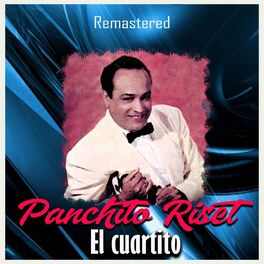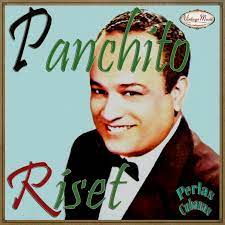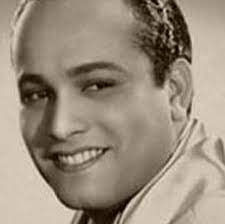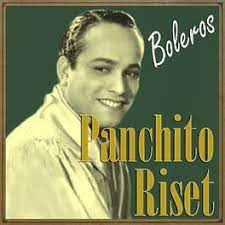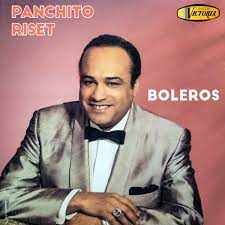“PANCHITO” RISET, EXITOSO CANTANTE CUBANO QUE INTERPRETÓ EL PRESAGIO DE SU DOLOROSA MUERTE. PHOTOS
Hay quien duda de los anuncios o presagios de lo que va a pasar en el futuro. Si pudieramos atender estos y lo que va a pasar en el futuro quizas pudieramos tambien prepararnos para lo que nos espera y esto sucedió en el año 1947 en la ciudad de Nueva York cuando el compositor cubano “Mundito” Medina escribió el bolero titulado “El cuartito”.
En esa época, una de las estrellas más populares en el ambiente musical de Nueva York era “Panchito” Riset. Para el cantante, todo era brillante y feliz. El se presentaba todas las noches en el Club Versalles de esa ciudad y sus discos se vendían por todo el mundo. Y Panchito aceptó cantarle a Medina su tema, sin saber que la canción para él sería profética, aunque en aquellos momentos de esplendor y fama, su mensaje no podría descifrar.
VIDEOS- PANCHITO RISET INTERPRETA “EL CUARTITO”.
CARRERA ARTISTICA DE PANCHITO RISET
Francisco Hilario Riser, su verdadero nombre, nació en La Habana, Cuba, en el barrio de Atarés, en 1910. Desde pequeño, aprendió a tocar el Tres, la famosa guitarra cubana de tres cuerdas dobles, y la guitarra acústica española, instrumentos con los que se acompañaba, pero poco a poco los abandonó para concentrase más bien en cantar.
Su primer incurso como cantante profesional fue con el Septeto Esmeralda, pasándose más tarde al Septeto Habanero y luego a la orquesta de Ismael Díaz.
En 1933, lo invitan a cantar con una de las orquestas más populares de Nueva York en ese entonces y se muda a esa ciudad, donde canta por un tiempo con la Orquesta de Antobal. Es con Antoval que graba una de sus primeras grabaciones y en el sello le ponen Riset (en vez de Riser) y, como para no tener que rehacerlos, así lo dejan.
En Nueva York, durante los años 30, Francisco Riser, ahora Panchito Riset, canta y graba, prácticamente, con todos los grupos musicales existentes en ese entonces: Cuarteto (de Pedro) Flores, Victoria, el Caney, y con las orquestas de Xavier Cugat y Enrique Madriguera. Además, actuaba continuamente en los cabarets de moda: Cubanacán, La Conga y Yumurí así también como en California, donde se presentó en 1936 en el cabaret Trovadero, mientras se lo disputaban los estudios de grabación.
Ciudadano de Estados Unidos, cuando rompe la II Guerra Mundial el deber lo llama, y Panchito se enlista en el ejército donde permanece hasta 1943, cuando lo deautorizan honorablemente, Panchito regresa a lo que más le gustaba, cantarle a su público, lo que hace cuando debuta en el cabaret, Versalles, y donde permanece por los próximos 18 años.
Panchito, a su regreso del servicio militar, siguió grabando, preferentemente con grupos que se amoldaban a su estilo, como los conjuntos de René Hernández y el de Luis “Lija” Ortiz, viajando esporádicamente por el Caribe. En sus presentaciones, con su voz e inconfundible estilo, Riset llevó al bolero la ingenuidad, la pureza en la expresión que existía en los años ‘30 y nunca buscó innovar su estilo. El invitaba al oyente a trasladarse con él a la simple y sosegada magia de la década de los 30.
De su estilo, muchos decían que se lo había copiado a Cheíto, uno de los cantantes del Sexteto Habanero, y si es cierto que Panchito, como Cheíto, cantaba en los sextetos como requinto, o sea, con una voz que se destaca sobre el coro (estilo de voz que Caíto perfeccionara para darle una característica única a los coros de La Sonora Matancera), pero realmente, lo de Panchito era algo distinto y mucho más a todo eso, porque Riset poseía en el registro alto un vibrato que a veces parecía un temblor en su voz pero que nunca perdía la afinación, cosa que le daba a sus interpretaciones un expresión no solo de apremio, sino también de sinceridad. La voz de Panchito Riset era la voz del amor angustiado, la que reconocían los que compraban sus discos, porque al fin, ¿quién no ha sentido las angustias del amor?
Lo interesante de su historia es que como otros cubanos (Antonio Machín, Bola de Nieve y Machito, entre otros) que disfrutaron de fama internacional, en su país natal, Panchito Riset no era muy conocido. Había salido de Cuba muy muy joven.
PANCHITO INTERPRETA SUS MELODIAS
No fue hasta mediados de los ’40 que los radioescuchas de una popular radioemisora habanera, Radio Cadena Suaritos, comenzaron a escuchar una nueva voz que no era la suave de Fernando Albuerne, la viril de Daniel Santos, o la cadenciosa de Bobby Capó, voces a las que ya estaban acostumbrados. Esta nueva voz era algo distinto: muy aguda pero melodiosa que cantaba en un estilo que, francamente, ya estaba padaso de moda.Y para acabar, la canción que interpretaba comenzaba extrañamente con una risa, seguía con una pregunta y continuaba después con la evocación nostálgica de la amada perdida y el nido de sus amores.
Era una canción que parecía un tango, y de hecho su tema recordaba a la percanta y el bulín de “Mi noche triste”, el primer tango que cantó Gardel. Era una especie de tango tropical, a ritmo de bolero. Uno de esos temas que se creían compuestos en una noche de farra, llenas de recuerdos, de mucho alcohol y de superabundante inspiración. En suma, una canción tanto sublime, como ridícula, y como tal, conquistó el corazón de las multitudes. A poco, “El Cuartito” de “Mundito” Medina, en la voz de Panchito Riset, se escuchaba por todas partes a nivel de saturación.
Más tarde, con la misma aceptación, siguieron “Blancas azucenas”, de Pedro Flores, de la cual el musicólogo Cristóbal Díaz Ayala dice que en su versión, uno casi podía olerlas y “Cita a las seis”, donde los oyentes hasta se ponían nerviosos al escuchar como como su voz esperaba a la amada.
Y así se mantuvo por décadas. Como el baluarte de la música popular de Nueva York, hasta que la salud le empezó a fallar. Pero aún así, nunca perdió su maravillosa voz.
Menciona Ayala que en septiembre de 1983, cuando se celebró el Telemaratón de la Sociedad de Niños y Adultos Lisiados de Puerto Rico en New York, la presencia y actuación de Panchito Riset arrancaron, al mismo tiempo, lágrimas y aplausos. Al presentarlo Pedro Zervigón, el público le obligó a interpretar varios números, entre ellos “Blancas azucenas”. Esa noche, fue la estrella que más brilló, aunque allí estaban Celia Cruz, Iris Chacón, Ruth Fernández, Mirta Silva y otras grandes figuras. Desde su silla de ruedas, seguía actuando hasta que la enfermedad pudo más que él.
Y se cumplió la profecía….el 8 de agosto de 1988 en un cuartito, olvidado y ciego, con las dos piernas amputadas a consecuencia de la diabetes, fallece Panchito Riset, y al destino le preguntamos… ¿Por qué ríes así? Amigos como el locutor y animador Angel Luis González Adames y Trini Márquez, del famoso Trío de las Hermanas Márquez, le asistieron hasta su muerte.
“PANCHITO” RISET, SUCCESSFUL CUBAN SINGER WHO SANG AND PERFORMED THE FUTURE OF HIS PAINFUL DEATH. PHOTOS
There are those who doubt the announcements or omens of what is going to happen in the future. If we could attend to these and what is going to happen in the future perhaps we could also prepare for what awaits us and this happened in 1947 in New York City when the Cuban composer “Mundito” Medina wrote the bolero titled “El cuartito”. ”.
At that time, one of the most popular stars in the New York music scene was “Panchito” Riset. For the singer, everything was bright and happy. He performed every night at the Versalles Club in that city and his records were sold all over the world. And Panchito agreed to sing his song to Medina, without knowing that the song would be prophetic for him, although in those moments of splendor and fame, he could not decipher his message.
PANCHITO RISET’S ARTISTIC CAREER
Francisco Hilario Riser, his real name, was born in Havana, Cuba, in the Atarés neighborhood, in 1910. Since he was little, he learned to play the Tres, the famous Cuban guitar with three double strings, and the Spanish acoustic guitar, instruments with those he accompanied himself with, but little by little he abandoned them to concentrate more on singing.
His first foray as a professional singer was with the Septeto Esmeralda, later moving to the Septeto Habanero and then to the Ismael Díaz orchestra.
In 1933, he was invited to sing with one of the most popular orchestras in New York at the time and he moved to that city, where he sang for a time with the Antobal Orchestra. It is with Antoval that he records one of his first recordings and on the label they call it Riset (instead of Riser) and, as to avoid having to redo them, they leave it at that.
In New York, during the 1930s, Francisco Riser, now Panchito Riset, sang and recorded with practically all the musical groups existing at that time: Cuarteto (de Pedro) Flores, Victoria, el Caney, and with Xavier’s orchestras. Cugat and Enrique Madriguera. In addition, he continually performed in the fashionable cabarets: Cubanacán, La Conga and Yumurí as well as in California, where he appeared in 1936 at the Trovadero cabaret, while he was competing for recording studios.
Citizen of the United States, when World War II breaks out, duty calls him, and Panchito enlists in the army where he remains until 1943, when he is honorably discharged, Panchito returns to what he liked most, singing to his audience, which he does when he debuted in the cabaret, Versalles, and where he remained for the next 18 years.
Panchito, upon his return from military service, continued recording, preferably with groups that adapted to his style, such as the groups of René Hernández and Luis “Lija” Ortiz, traveling sporadically through the Caribbean. In his presentations, with his voice and his unmistakable style, Riset brought to the bolero the naivety, the purity of expression that existed in the ’30s and never sought to innovate his style. He invited the listener to travel with him to the simple and calm magic of the 1930s.
Regarding his style, many said that he had copied it from Cheíto, one of the singers of the Habanero Sextet, and if it is true that Panchito, like Cheíto, sang in the sextets as a requinto, that is, with a voice that stands out above the choir (voice style that Caíto perfected to give a unique characteristic to the choirs of La Sonora Matancera), but really, Panchito’s thing was something different and much more than all that, because Riset had a vibrato in the upper register that sometimes There seemed to be a tremor in his voice but he never lost tune, which gave his interpretations an expression not only of urgency, but also of sincerity. Panchito Riset’s voice was the voice of anguished love, the one recognized by those who bought his records, because in the end, who has not felt the anguish of love?
The interesting thing about his story is that like other Cubans (Antonio Machín, Bola de Nieve and Machito, among others) who enjoyed international fame, in his native country, Panchito Riset was not well known. He had left Cuba very, very young.
PANCHITO INTERPRETS HIS MELODIES
It was not until the mid-1940s that listeners of a popular Havana radio station, Radio Cadena Suaritos, began to hear a new voice that was not the soft one of Fernando Albuerne, the virile one of Daniel Santos, or the lilting one of Bobby Capó, voices to which they were already accustomed. This new voice was something different: very high-pitched but melodious, singing in a style that, frankly, was already out of fashion. And to finish, the song it sang began strangely with a laugh, continued with a question, and then continued with the evocation nostalgic for the lost beloved and the nest of her loves.
It was a song that seemed like a tango, and in fact its theme was reminiscent of the percanta and bulín of “Mi noche triste”, the first tango that Gardel sang. It was a kind of tropical tango, to the rhythm of a bolero. One of those songs that were believed to have been composed on a night of partying, full of memories, lots of alcohol and overflowing inspiration. In short, a song that was both sublime and ridiculous, and as such, it conquered the hearts of the crowds. Soon, “El Cuartito” by “Mundito” Medina, in the voice of Panchito Riset, was heard everywhere at saturation level.
Later, with the same acceptance, followed “Blancas azucenas”, by Pedro Flores, of which the musicologist Cristóbal Díaz Ayala says that in his version, one could almost smell them, and “Cita a las seis”, where the listeners even became nervous to hear how his voice was waiting for the beloved.
And it remained that way for decades. As the bastion of popular music in New York, until his health began to fail him. But still, he never lost his wonderful voice.
Ayala mentions that in September 1983, when the Telemarathon of the Society of Crippled Children and Adults of Puerto Rico was held in New York, Panchito Riset’s presence and performance drew tears and applause at the same time. When Pedro Zervigón introduced him, the audience forced him to perform several numbers, including “Blancas azucenas.” That night, he was the star that shone the brightest, although Celia Cruz, Iris Chacón, Ruth Fernández, Mirta Silva and other great figures were there. From his wheelchair, he continued performing until the disease got the better of him.
And the prophecy was fulfilled…on August 8, 1988 in a small room, forgotten and blind, with both legs amputated as a result of diabetes, Panchito Riset died, and we asked destiny… Why do you laugh like that? Friends such as the announcer and entertainer Angel Luis González Adames and Trini Márquez, from the famous Márquez Sisters Trio, assisted him until his death.
Agencies/ Wiki/ ElVerasPR/ PanchitoRizetBio./ Extractos/ Excerpts/ Internet Photos/ YouTube/ Arnoldo Varona/ www.TheCubanHistory.com
THE CUBAN HISTORY/ HOLLYWOOD.



